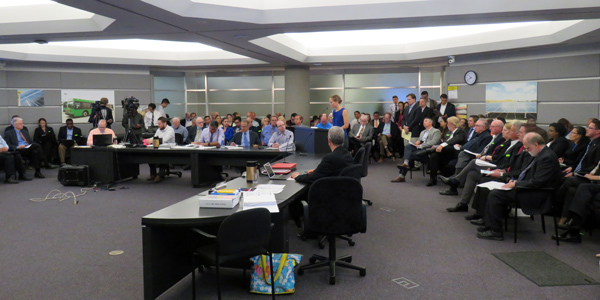By Jason Fordney
SACRAMENTO, Calif. — The California Energy Commission rocked the energy world Wednesday when it unanimously approved a mandate requiring new homes in the Golden State to include rooftop solar, making it the first state to move to adopt such a rule.
The 2019 Building Energy Efficiency Standards would apply to most newly constructed buildings and additions to existing structures built after Jan. 1, 2020, requiring builders to add solar panels and encourage battery storage systems and heat pump water heaters to improve energy efficiency. They also update standards for indoor and outdoor lighting by incentivizing maximum usage of LED lighting in non-residential buildings.
The proposed rules also include three other major components in addition to solar: updated thermal envelope standards that prevent interior/exterior heat transfer; residential and nonresidential ventilation requirements; and nonresidential lighting requirements. California for the first time extended the standards to health care facilities.
The package still requires approval from the state’s Building Standards Commission. CEC spokeswoman Amber Pasricha Beck told RTO Insider the building commission usually approves what the CEC sends over.
In discussion ahead of the vote, CEC members said the measure will cut energy bills and reduce greenhouse gas emissions, noting that the cost of solar panels has dropped dramatically in recent years. The vast majority of comments filed in the proceeding favored the changes.
CEC Chairman Robert Weisenmiller said that California has expanded its economy in recent years even while reducing greenhouse gas emissions. Implementing the standards will require close work between the commission and the building industry, which he said he wants to keep “vibrant.”
“This is just a milestone, but there is a hell of a lot of work to go between now and 2020, and we really have to keep our eye on the ball to make this work smoothly,” Weisenmiller said. “There will be some surprises, and we will need to stay on top of this, but the bottom line is we are going to focus on making this happen.”
“Once we get there, yeah, we can talk about the future,” he added.
The CEC’s Wednesday meeting drew an unusually heavy media interest for a commission decision, and by the evening even the BBC had picked up the story.
The measures will make it more expensive to build new homes in a state already known for some of the highest housing and construction costs in the country, but the commission said it will be worth the expense.
While the new standards will add about $9,500 to the cost of a new home, they will save homeowners $19,000 in energy and maintenance costs over 30 years, the CEC said. The changes would add about $40 to the average monthly mortgage payment but save $80 per month on heating, cooling and lighting bills. Nonresidential buildings will use about 30% less energy under the standards, mainly because of lighting upgrades, according to the agency.
The explosion of rooftop solar in California has led to massive amounts of solar output coming online and offline each day as the sun rises and sets, requiring increased use of fast-ramping generation resources to compensate for the variability. Asked about the impact on California’s “duck curve” that illustrates the steep ramps, CAISO spokesman Steven Greenlee said Thursday that zero-net energy home projections are included in the CEC’s Integrated Energy Policy Report (IEPR) forecasts, which the ISO uses in its transmission planning process.
“Our planning already takes into consideration state policies,” Greenlee told RTO Insider. “We have been managing increasing amounts of renewables coming onto the grid for many years and use the IEPR forecasts for transmission planning. However, as the amount of renewables on the system grows, grid operators need increased visibility into behind-the-meter resources, including developing practices for aggregated information sharing and operational coordination.”
Solar Energy Industries Association CEO Abigail Ross Hopper said: “This is an undeniably historic decision for the state and the U.S. California has long been our nation’s biggest solar champion, and its mass adoption of solar has generated huge economic and environmental benefits, including bringing tens of billions of dollars of investment into the state.”
California Building Industry Association CEO Dan Dunmoyer said the standards “struck a fair balance between reducing greenhouse gas emissions while simultaneously limiting increased construction costs.”
Parties issuing statements in favor of the proposal include the Natural Resources Defense Council, Habitat for Humanity San Joaquin County, California Solar & Storage Association, California Air Resources Board, Southern California Edison, Pacific Gas and Electric, and Tesla.
Opposition to the standards was mostly limited to individual commenters, some addressing aspects of the standards other than the rooftop solar mandate.
At the meeting, longtime Colorado-based energy attorney and consultant Peter Esposito said he only learned of the rooftop solar proposal on Tuesday.
“I initially thought it was ‘fake news,’ and I would like to add that I think you are making a big mistake,” Esposito said. He advocated against a technology-specific approach and said consumers should be able to choose how to meet greenhouse gas emission goals.
“Please don’t lock out other technologies,” he said, without being specific as to what particular technologies he was referring to.






